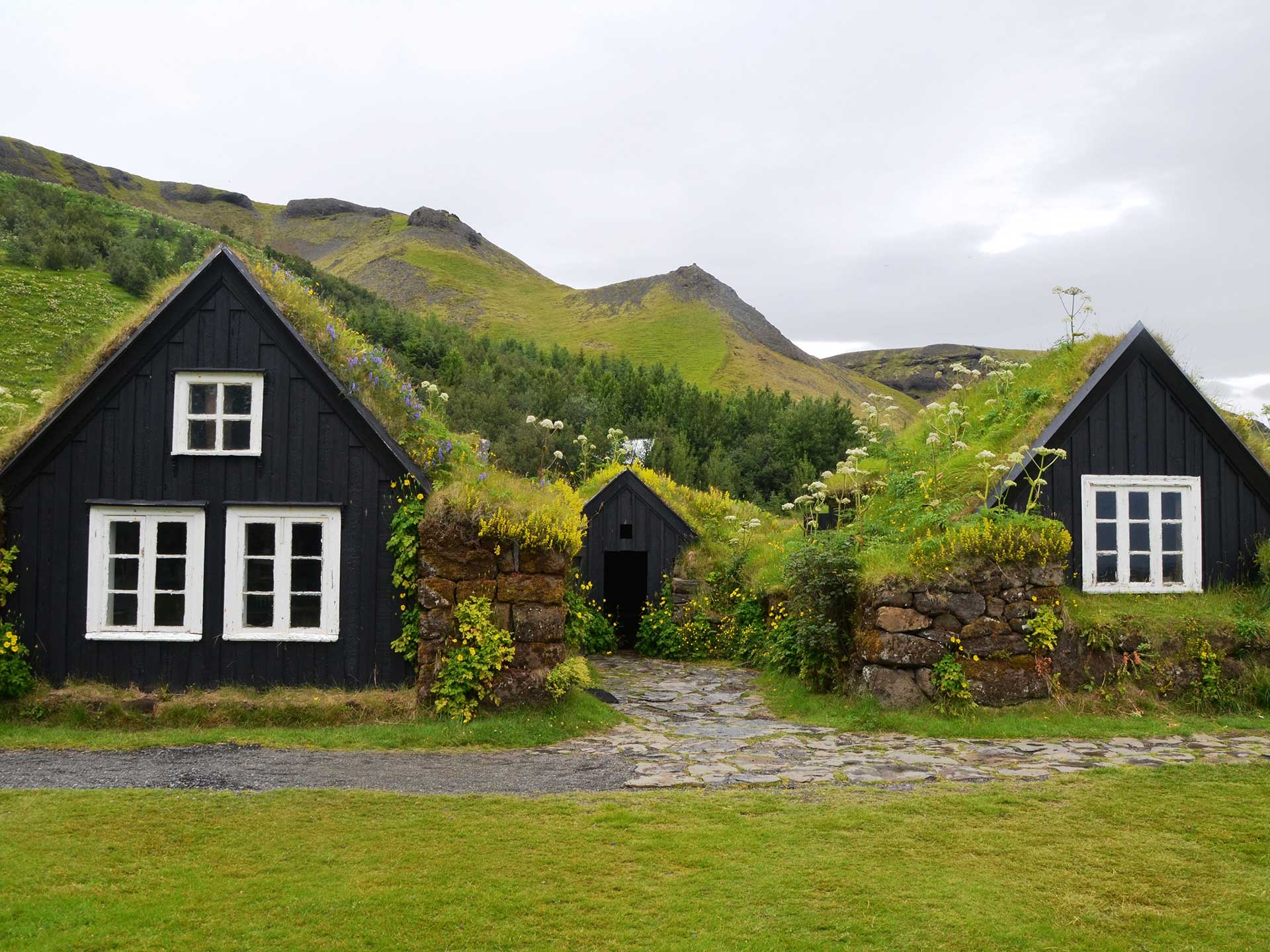Green roof guide – everything you need to know
Green roofs are designed to support plant growth and come with a myriad of benefits. Read this guide to see if it's suitable for your home.
In a world where climate change is increasing rapidly, our homes must be more able to withstand the elements and work with the environment rather than against it. Green roofs are designed to support plant growth and come with a myriad of benefits.
Not that they’re a new concept by any stretch, roofs covered in vegetation have been around for thousands of years. From the necessity of design in the Arctic and Scandinavian regions, sod roof (also known as turf roof) houses have been common since the Middle Ages. They were built by layering wide sheets of birch bark on the sloping roof and then adding two layers of turf on top. The first layer acts as drainage, and in time, the roots of both layers will bond together. If you travel to the Faroe Islands you can still see hundreds of traditional green roofs constructed using this ancient technique.
What is a green roof?
Green roofs, also known as living roofs, sedum roofs and grass roofs, are roofs that are partially or fully covered with grass, plants and vegetation. Green roofs can improve your home’s sustainability, help it blend in better with its natural surroundings and bring an additional natural ecosystem for wildlife to your plot.
While technology has moved on since the days of a turf roof, a green roof will still need a system, and it works by being made up of several layers. Starting with the vapour control layer (this will prevent water vapour from forming through the roof and creating condensation). Then the there’s the waterproof root barrier membrane, it’s extremely important to get this layer right to prevent any water leaking into your roof and causing rot or decay. Then a layer of protection and moisture fleece (you can get ones made from 100% recycled polyester and polypropylene fibres). This will protect your waterproof membrane during the green roof construction and keep the right amount of water within the soil.
A drainage layer and water retention board are then added. Again, this layer is imperative. There are various materials on the market in varying degrees of eco-friendliness. On top of the drainage layer you’ll need to add a filter sheet. Sitting between the drainage and substrate layers, the filter is a horizontal layer that lets water pass through to the drainage layer, but keeps out soil fines.
Finally, it’s the substrate layer, and you must use something that’s been specifically designed for a green roof. BS8616 is the British Standard code for green roof substrates, which means the substrate will have the following qualities:
- Lightweight to mitigate any extra weight to the roof
- Well aerated. It should should hold sufficient water but also have good drainage to prevent water build-up
- Be able to aid optimum levels of plant growth, therefore not overgrowth or undergrowth. This can be monitored with controlled nutrition levels and chemical properties.
Ensure the top substrate layer is not taken to the roof’s edges. A shingle perimeter (regularly checked to be free of weeds) is necessary for water to move through and be taken off the roof. You’ll need to add a downspout (a vertical extension added to the gutter trough) for this.
Green roof vs solar panels
There are pros and cons to green roofs vs solar panels, and it will remain dependant on your specific needs. As a general rule solar panels will have a higher initial outlay, for example according to the Eco Experts “a standard four-inch extensive green roof costs around £8-17 per square foot, while 350W solar panels cost around £26 per square foot”. However, they also say that you’ll break even on your investment quicker with solar, so it could even out.
Solar panels are better for reducing your energy bills by a higher percentage, but a green roof will typically outlast a solar panel roof. And while solar panels will be subject to technology increases and better ones on the market coming out. You won’t have that worry with plants!
From an aesthetic point of view, a green roof will look more attractive, but a green roof (and this is dependent on which type you go for) will require a significant amount of higher maintenance. A great compromise is investing in a bisolar roof, which combines the benefits of a green roof and a solar roof.
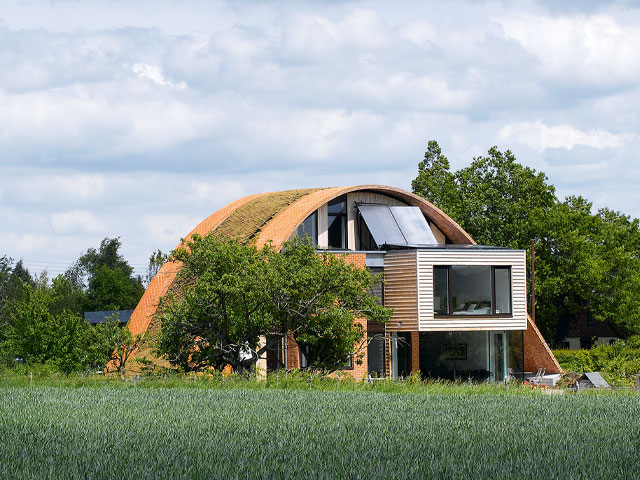
Image credit: Jefferson Smith
Benefits of a green roof
Let’s start with the appeal. Adding a green roof to your property can help integrate the building with nature and soften its look in the surrounding environment. Grand Designs couple Dorran and Vereuschka’s undergound house in Canterbury (pictured below) is covered with a specially blended earth to support the growth of shrubs and meadow plants on their meadow roof. As the greenery matures over time, there will be little evidence that there’s a house there at all.
While you might not be in the market for creating an entirely underground house, there are still major advantages to having a green roof, including increasing energy efficiency. Many roofs have poor insulation, but if you cover it with plants, it’ll bring increased insulation. It will absorb the sun’s energy, resulting in a temperature reduction in the roof in the summer and an overall reduction in the ambient temperature of your home and its immediate surroundings. And in the winter it will hold the heat for added thermal efficiency in the winter. Something to consider when thinking about the increasing extreme weather that we’re seeing globally.
As pollution levels in the UK continue to rise, the addition of a green roof can help to improve air quality as they absorb Co2. A Green Roofers survey has found that living roofs can help with a “37% reduction in sulphur dioxide, 21% of nitrous acid and 0.2kg of dust particles per square metre each year”. As well as improving air quality and not adding heat to the surrounding environment, green roofs help replace the site’s ecology and provide natural flora and fauna and a haven for birds and insects. Green Solutions company Sky Gardens has reported an approximate “8-12% increase in insects per meter squared” on a green roof.
Green roofs act as a natural water management system, they absorb a large proportion of rainfall, up to 70%, which can help mitigate flooding and overwhelming local drainage systems. This can help with storm management and reduce problems with flash floods and surface run-off. Check out Bauder’s video on how a green roof manages rainfall.
If you live in an urban environment, noise cancellation might be a priority in your home. Green roofs can help reduce the ambient sound both inside and outside the home, by absorbing much of the noise, for example, busy traffic. Green roofs dampen sound waves as opposed to traditional hard roofs which can reflect sound.
Given all the protection plants will give your home by shielding it from the elements it can increase the lifespan of your roof by years, helping you recoup its investment and reduce roof maintenance or replacement costs. All of these factors will add value to your home.
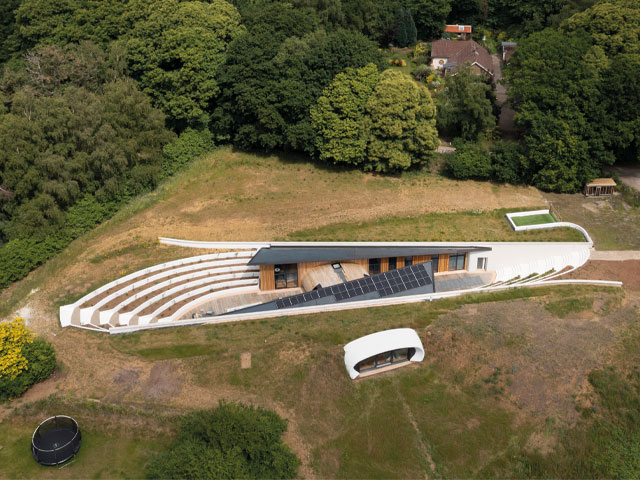
Image credit: Jefferson Smith
Disadvantages of a green roof
While there are a huge amount of positives that come with installing a green roof, there are some considerations to make before you start your project. Primarily, installing a green roof will come with a substantial additional weight. Particularly intensive green roofs and the roof and load-bearing walls may not be strong enough to support it, so added structural support may be required. Check with a chartered structural engineer or a surveyor to look over your design and its weight implications. Depending on how complex your design is, you might also need a specialist roof garden architect. You’ll need to think about your pitch, as a green roof cannot be installed on a roof pitch that’s higher than 30 – 45 degrees.
Green roofs absorb large quantities of water, and while this has many benefits, in the event of a leak, it can cause huge problems, for example, if the roots of any of the plants or shrubs penetrate the membrane layer. Although yearly inspections to check the plants and a shallow growing medium should be sufficient to minimise this happening. Of course, annual checks come with cost implications, as does the roof installation itself. The height of a green roof can leave it vulnerable to strong winds and wind damage, so slatted or mesh screens can be installed to filter the wind to leave the garden less exposed.
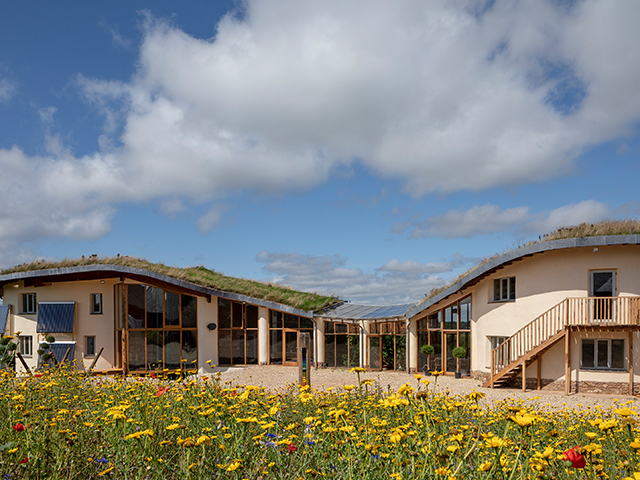
Image credit: Channel 4
What types of green roof are available?
In the UK there are three main types of green roof for you to consider. The type of green roof you invest in will determine what you can plant on it.
Extensive
An extensive green roof is the thinnest of the three green roof types, and therefore the lightest and most common. Depth wise you’re looking at around 5-15 cm (2-6in) of growing medium, which RHS says “can consist mainly of lightweight inorganic materials such as perlite, leca, sand, rockwool and crushed tiles or concrete”. You can buy ready-grown mats of sedum (a lightweight and drought-resistant plant), which is low-maintenance and should only need watering during long dry spells. Your roof will need to be accessible for you to reach it. Sedum, sempervivum, moss, rock aster and ferns are all suitable plants for an extensive roof.
Semi-extensive
The semi-extensive green roof is the next step with a greater depth, needing around 10-20 cm (4-8 in) of growing medium. This will be enough to support perennials, but not shrubs and trees. RHS recommends that “semi-extensive green roofs take 12-18 months to establish, during which time they will need maintenance. Hand weeding, watering and feeding are all necessary”. So, again you’ll need to make sure the roof is accessible. A semi-extensive roof could be a good option if you’re thinking of installing a green roof on your garden shed. Ornamental grasses, bulbs from the allium family, and dry habitat perennials work on a semi-extensive roof.
Intensive
As the name suggests this is the most involved of all the categories and comes with the most maintenance and heaviest weight. It’s more of a complete garden than a green roof and is commonly seen on commercial buildings. They require at least 30cm (1ft) of organic growing medium.
You’ll need an architect and planning permission for the design of an intensive roof, and it will have to be built on a flat roof for people to stand on. Drought-tolerant plants, like yarrow, will be needed on an intensive roof type, and they can cope with shrubs and trees. Intensive green roofs are often built to enjoy, so adding a sensory garden could enhance your building. The High Line in New York is a great example of the use of green roof technology.
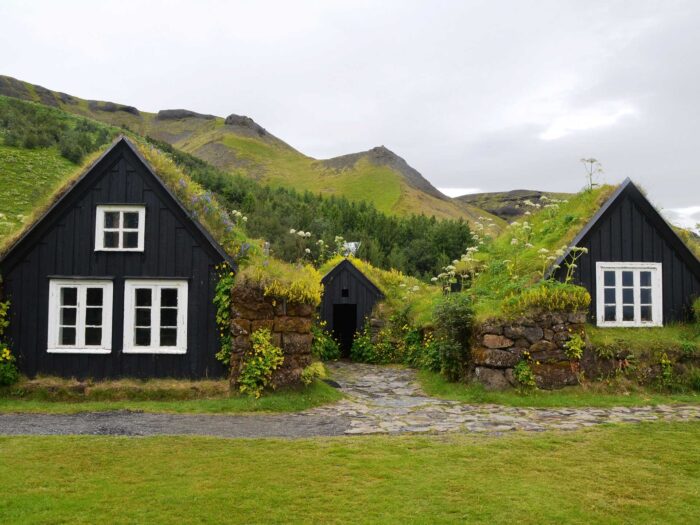
Image credit: Pexels/Pixabay

